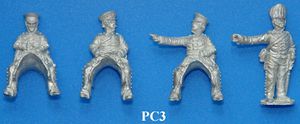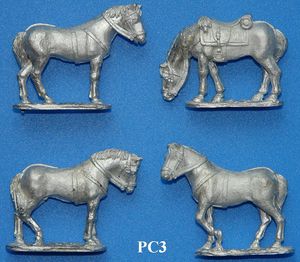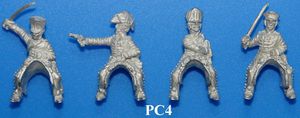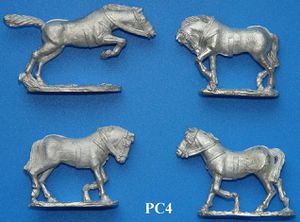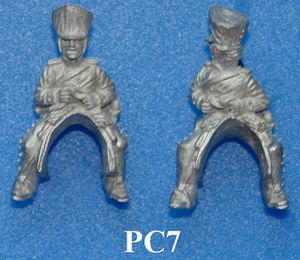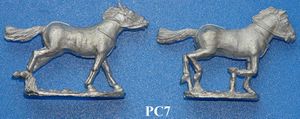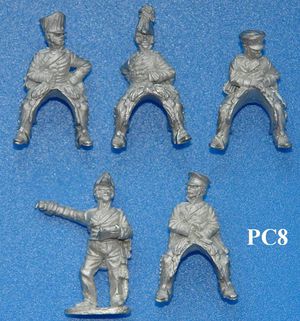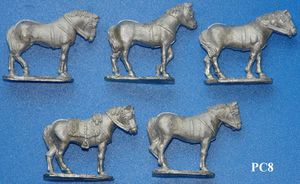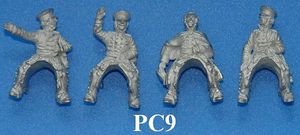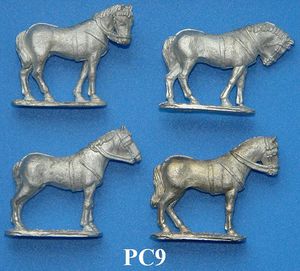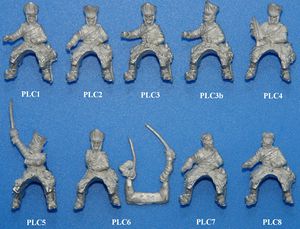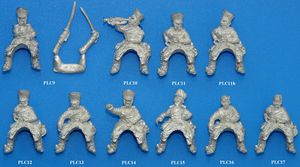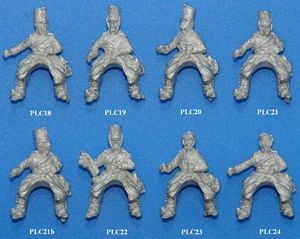Calpe Miniatures Prussian — различия между версиями
Anchar (обсуждение | вклад) (→Kurmark Landwehr) |
Anchar (обсуждение | вклад) (→Line Uhlans) |
||
| Строка 206: | Строка 206: | ||
== Line Uhlans == | == Line Uhlans == | ||
| + | NB: Release date 1st March 2006. | ||
| + | |||
| + | These figures are designed to represent the line Uhlans as they would have appeared on campaign. My primary reference for these figures is Peter Bunde’s Brigade plate on the subject (plate no. 124). This remains the most reliable and readily available source of information on the Uhlans. Some of the other plates mentioned below are now very difficult to acquire. Other sources of information are the plates by both Richard and Herbert Knotel, the Brauer Uniformbogen plates, the LTR plates on the Prussian volunteer jaegers and the 'Sturm-Zigarettenbilder-album' cards. | ||
| + | |||
| + | The first thing I should point out is that the Uhlans have been sculpted wearing their dress coats, the Kollet, not the Litewka. Although the Litewka was issued, it is rare to see an illustration in which they wear this item of uniform. Peter Bunde finds a good explanation for this in his plate. He points out that they looked exactly like landwehr cavalry when they wore the Litewka. They thus avoided being confused for militia cavalry by wearing the Kollet even when on campaign. | ||
| + | |||
| + | The Kollet was Prussian blue with poppy red collar and cuffs. The cuffs came to a point and were adorned by a brass button just below the point. The turnbacks were the same blue as the jacket but were set off by a ribbon of poppy-red piping along the outer edge of the turnback. They also had a distinctive brass button at the 'join' of the turnback and one on the jacket beside the apex of the turnback and just below the sash. These are not shown on the Brigade plate (possibly the only omission) but they are shown clearly on the Knotel and Brauer plates. The distinctive Uhlan sash was the same colour as the jacket and was also piped, top and bottom, with the same red ribbon as on the turnbacks. There was a single centrally placed 'barrel' on the sash. It was also blue with red piping but with the pattern lines running vertically instead of horizontally as on the rest of the sash. The colour of the shoulder straps denoted the regiment — white/Westprusssian, red/Silesian, yellow/Brandenberg. No decorative cords were worn on either shako or Kollet when on campaign. Trumpeters had a line of gold piping along the upper edge of the cuff and the opening and lower edge of the collar. Their 'swallow nests' were red with gold piping. The trumpet cords were similarly coloured in red and gold. | ||
| + | |||
| + | On campaign the shako was always worn in its black oilskin cover and devoid of all ornamentation. The cavalry overalls were the usual grey with a thin strip of poppy red piping along the outer seam and black leather reinforcements along the inside and bottom of the leg. All leather equipment was black. There was no plate on the cartridge pouch with the exception of the officers who displayed a yellow metal 'Royal cipher' here. Officers also had yellow metal 'pickers and chains' on the front of their cartridge belts. Officers wore the appropriate rank epaulets not the men’s shoulder straps (see the brigade plates for further information). The sword hilt and scabbard were polished steel for all ranks and the sword knot was black for troopers and the usual silver for officers. | ||
| + | |||
| + | The shabraque was the Prussian light cavalry sheepskin with a red edging. The usual accoutrements were draped about the shabraque including the canteen in a grey cover the valise also in grey and the canvas forage bags. | ||
| + | |||
| + | The description I have given above is necessarily brief. For further information refer to Brigade plate no. 124. | ||
| + | |||
| + | === Catching Points === | ||
| + | The rubber moulds really do dislike the canteen on the left rear of the shabraque. Although I have tried several different solutions to this, the canteen continues to catch and to cause small tears in the mould. A certain amount of 'cleaning' of the casting may be necessary on the lower edge of the canteen. | ||
| + | |||
| + | === Prussian Line Uhlans: Advancing === | ||
| + | Below are pictures of PCU1 to PCU11. Note that figures are supplied unpainted and without lances. Horses are available separately. Perry Miniatures make excellent pikes that can be used as lances if cut down to a length of 5.5cm. | ||
== Horses == | == Horses == | ||
Версия 21:26, 1 января 2017
Содержание
Artillery
Command
Organising Your Command Sets
The Prussian army of this period was organised into three corps. For the campaign in Germany in 1813 these were separated and placed in three of the four allied army groups. Blucher commanded the Army of Silesia but only one of his corps was Prussian (with York in command) the rest were Russian. The commanders of the two other Prussian corps were Bulow and Kliest. For the Waterloo campaign a fourth corps was added and the army operated as a joint entity. In this case the corps commanders were Zieten, Pirch, Thielmann and Bulow.
All corps were organised into four brigades. Each of these had three infantry regiments of three battalions. In 1813 these also had one or two regiments of cavalry attached and at least one 6pdr. battery so that each brigade was a self contained fighting force of all arms. In addition to these four brigades there was a separate cavalry reserve of at least one brigade (some had two cavalry brigades). Each of these reserve cavalry brigades was composed of (at least) three regiments of cavalry. There was also an artillery reserve with its own command element.
This first release of four command sets is designed to cover the four ‘infantry’ brigades that composed the real fighting element of each Prussian corps. Each set is made up of a General, his ADC, a General Staff officer and a Feldjaeger. Command groups for the cavalry and artillery reserves of the corps will follow.
Uniform Notes for the Generals and Their Staff
The preferred order of dress of the Prussian general officer in the field, as well as that of his staff, was the uberrock (frock coat) and the peaked cap. There is little doubt about this although uniform plates of officers wearing these items are rare. This ‘undress’ clothing was considered personal rather than regulation wear, so it was not a uniform item in reality. What this means is that the cut of the Ubberock was not prescribed, it was down to the officers’ (and their tailors’) fashion sense so making it difficult for an artist to represent a ‘standard’ uberrock (this information supplied by Peter Bunde). Infantry generals (and their staff) had grey uberrocks and caps, cavalry had blue ones. The lapels of the uberrock were lined in red and could be turned back to expose a flash of colour at the neck. The cuffs were plain. There is evidence in some of the better battle paintings that many officers’ uberrocks may have had the buttons and retaining straps sewn onto the garment at the shoulder to enable them to attach shoulder straps or epaulets. It is rare to see shoulder straps or epaulets on the uberrock so these attachments remained unused. I have sculpted the buttons and retaining straps on the figures for the sake of historical accuracy; the buttons should be in gold and the retaining straps in silver.
Generals sometimes wore their Kleine uniform in the field. The literal translation of this is the ‘Little uniform’ a better translation might be the ‘simple’ uniform. This was basically a blue kollet with red collar, cuffs and turnbacks. There was no lace on collar or cuffs. The cuffs were ‘Swedish’ cuffs with two gold buttons as the only decoration. The shoulder straps were plaited silver wire. The ADCs and other staff officers often wore the Liebrock on campaign. This was blue for both infantry and cavalry ADCs. The jacket was single breasted and had a large fold down collar. This collar was green for ADC’s (frequently, but not always, piped in red) and red for staff officers. The Swedish cuffs were similarly coloured. Turnbacks were red for infantry officers and white for cavalry. The field of the shoulder strap also differed for cavalry and infantry officers. It was white for the former and blue for the latter. The officer’s rank lace on these epaulets was silver for both. The lapels of the Liebrock were also lined in red and could be turned back to expose the coloured lining.
Officers were not supposed to wear the silver waist sash when wearing the uberrock or the Liebrock. This regulation was generally disregarded and most officers wore the sash in the field with both items of clothing (although it seems to have been less frequently used with the Liebrock).
All officers’ saddle cloths are described as being made of black bear fur. Generals and staff officers had ‘guard’ stars at the rear of the saddle cloth and on the pistol holster covers. ADC’s had no stars on their saddle cloths. The stars were silver with an orange centre.
Many officers wore medals and other decorations on their coats. These were principally iron crosses of various classes but generals also wore a silver star to the left of their chest. All coat buttons were in yellow metal. Sword straps were silver.
The General Staff Officers
Although I have described the uniform details above, I need to emphasise the importance of these officers in the context of these brigade command groups. Until I did the research I did not appreciate the special status of these officers in the reformed Prussian command setup. Each brigade and corps commander had a general Staff officer attached. These can best be described as a parallel commander. The General Staff officer’s job was to remind the brigade commander of the army’s plan of action and to ensure that the General’s actions complied with this plan. He was an advisor to the brigade commander but not a subordinate as such. He was answerable only to the head of the General Staff (Gneisenau, after Scharnhost was injured) who in turn reported directly to the king. It would be fair to say that the brigade was under dual command, the general gave the orders but only as long as these complied with the plans of the General Staff!
The Feldjaegers This corps was a legacy from Fredrick the Great. They were the staff couriers and guides. All the men in this formation were either NCOs or officers. Their special status was reflected in their uniforms, not only were these green in colour, but the NCOs uniforms were cut like the officers’ so that they had long tails and officer-type shoulder straps. Officers and NCOs uniforms differed only in that the officers wore the silver waist sash and had silver rank distinctions on their shoulder straps. The NCOs had gold piping on their shoulder straps and no waist sash.
All Feldjaegers wore green jackets with red collars cuffs and turnbacks and grey cavalry overalls. The field of the shoulder strap was green. On campaign the covered shako completed the uniform. They all carried sabres in white metal scabbards and a red leather satchel for carrying dispatches and orders. The saddlecloth was green with a broad yellow edging stripe. They also carried a brace of pistols in bearskin covered saddle holsters.
Assembly Notes
Most of these figures have been designed to fit specific horses. Some of these figures are the first to be sculpted to fit on Alan Marsh’s ‘Dynamic’ horses. These figures come in a plastic bag with the horses they are designed to fit. The exception to this is in Set Two. Since three of the figures are standing, their horses are designed to look as if they are tethered together. There is a sprue in the pack with lengths of metal rope which will need to be glued to the holes in the horse’s heads to make them look as if they are tied together (the central horse in the group is the one with three holes in it’s head). Some filling may be required. The long length of rope goes from the central horse’s head to the hand of the ADC. Set Three also has a standing feldjaeger figure holding the reins of his horse. Note the point on the left of the horse’s head where the feldjaeger’s fingers have made an impression in the reins to mark the point where the two figures join.
| Code | Description |
|---|---|
| PC1 | The brigade commander is watching the attack through his small telescope. He likes this telescope as it fits into his coat pocket when not in use. The three battalions of his Landwehr regiment took the village this morning but were thrown out in disarray by a concerted Saxon counterattack. To their credit the Landwehr infantry regrouped on reaching his lines and are now supporting his reserve infantry battalions as they try to force the stubborn Saxon infantry out of the village. As he watches he suddenly sees the Saxons streaming out of the other end of the village, running towards the cover of the woods. He snaps his telescope shut and whirls round in the saddle to get his brigade cavalry to intercept the fleeing Saxons. As he turns he pulls on the reins causing his horse to shy back. The sudden movement startles the staff officer’s horse and it rears up. The staff officer manages to keep his seat and brings the animal under control. Meanwhile, the ADC has spurred his horse towards the General and leans forward in his saddle so that he can hear the orders over the noise of the continuing battle. At a discrete distance, the Feldjaeger officer watches and prepares his leather satchel for the stream of orders which he knows will now follow.
The uniforms (and telescope) details are taken from a Brauerbogen plate. The general wears his Kleine uniform with the unbuttoned uberrock over the top and a covered cap as headgear. The General Staff officer is in uberrock and cap with his notebook tucked into the front of his uberrock. The ADC wears his kollet and bicorn in a weatherproof cover. The feldjaeger officer wears the standard uniform (note the waist sash). |
| PC2 | The General and his staff stand on a hill to the left of the road to Berlin. Below him he can see his brigade in their battalion formations straddling the road. His brigade is acting both as the Corps reserve and as the cover for the road to Berlin. This is the Corp’s escape route should things go badly for them today. He watches through his telescope as two of the other brigades from his corps engage Oudinot’s army of Berlin in an attempt to stop its advance towards the capital. His ADC stands behind him holding the tether which keeps their horses from bolting. The action commenced several hours ago and reports so far seem encouraging. The general hears galloping behind him. He turns in time to see a Feldjager NCO rein in his horse while holding out a parcel of orders. The General Staff Officer is already striding towards the courier, arm outstretched. Action at last!
The General and the General Staff officer both wear the Uberrock and cap. The latter has a map case slung over his left shoulder. The ADC wears his Liebrock without his sash and a covered bicorn, a uniform pared down for action. The Feldjaeger NCO is in the regulation uniform. |
| PC3 | The General knows what his brigade has to do this morning. If his men do not hold Ney’s troops back from the approaches to the river they will harass Bernadotte’s army of the North as they cross the pontoons in their effort to link up with Blucher’s army of Silesia outside Leipzig. He is fully aware of how little it takes to discourage Bernadotte. Both his corps commander and the General Staff officer on his staff have made it abundantly clear. Ney’s troops are battered but not beaten. They are still capable of inflicting a severe reverse which will impact immediately on Bernadotte’s resolve. He sits on his horse, carefully going over the plan again. He points out where he wants his dispositions. His ADC takes notes, resting his notepad on the front of his saddle. The General Staff officer sits to his right, listening and adding the occasional comment. The Feldjaeger NCO stands by his horse, ready to mount as soon as the ADC hands him the orders.
All officers wear the uberrock and cap. The General Staff officer has his cap covered and has a map case slung over his left shoulder. The ADC has a telescope case slung from his left shoulder. The Feldjaeger wears the regulation uniform. |
| PC4 | The armies have finally linked up and Napoleon is trapped inside the city. The General’s brigade is leading the Corp’s attack through the outskirts of Leipzig. Yesterday’s battle did not go well and his losses were greater than he would have liked but the Saxons have defected and Napoleon’s position is not good. He watches as his battalions press forward. There is a shout to his left. He turns his horse and sees a Feldjaeger NCO galloping towards him pursued by three French Chasseurs. The General Staff officer has already pulled out a pistol. His ADC draws his sword and spurs his horse forward. The General grasps the hilt of his sword but pauses as the Feldjaeger’s horse leaps over the bushes bordering the field. At that moment, the General Staff officer fires his pistol. The lead chasseur’s horse tumbles and rolls, trapping his rider beneath him. The other two chasseurs turn their horses and gallop back towards their own lines.
Uniforms from Knotel’s painting of the death of Hessen-Homburg (a Brigade commander in Bulow’s corps). The general wears the Kleine Uniform with a covered shako. The General Staff officer wears his Liebrock (in this case with a sash) and a covered bicorn. The ADC wears his Kollet but with his peaked forage cap. The Feldjaeger wears regulation uniform. |
| PC5 | When the order came that he was to break off the pursuit of the routing enemy troops the general found it hard to contain his anger. Looking back now there was no doubt that the order had been correct. A brigade of enemy cavalry supported by infantry had appeared on the edge of the battlefield: too late to influence the result of the battle but dangerous nevertheless. He had recalled his cavalry immediately and led his formed reserve of two regiments towards the threat on the army’s flank. He arrived at dusk to see the French forming up on the edge of a wood. Their infantry support could be seen moving through the wood, still in ‘column of march’. He had a split moment to make his decision. He ordered his two regiments to charge the French before they could form up completely. His cavalry had deployed and carried out his orders almost in darkness. He watched as they gathered pace but lost sight of them as they went into the gallop. He was now trotting towards the sound of battle in some trepidation. Have the French broken or did they have enough time to form up before they were struck by his charging troopers?
The general trots forward flaked by his trumpeter and his General staff officer. His ADC has galloped forward to find out the result of the charge. He pulls up his horse as the General approaches points towards the enemy and yells out that the French are routing. This is based on the closing episode of the battle of Gross-Beeren. The French were struck by the Prussian charge in the dark while still in some disorder and confusion. The whole brigade dissolved, most of it galloping into the open ground where the exhausted Prussian army captured them. A large group of French troopers actually rode through Bulow’s headquarters. The General wears his Uberrock (this would be blue as he is a cavalry officer) with the lapels turned back. He also wears his bicorn but without its protective cover displaying the black and white plume. The General staff officer wears his Uberrock and cap (grey for staff officers). The trumpeter is from one of the corps’ cavalry regiments. He wears his pelisse to ward off the cold. The ADC has copied his general’s flamboyance and wears his white Kollet with a covered bicorn. |
| PC6 | He sits on his horse looking at the French through the telescope his ADC has just handed him. He watched all morning as the infantry from both sides fought for possession of this vital high ground — the Denkmalsberg. His guns duelled with the French batteries stationed here and provided the necessary support for the advancing Prussian battalions. The enemy have re-formed around the Dennewitz windmill at the base of the hill. They must know what will follow. They can see his 12 pounders deploying on the crest of the hill. His ADC has turned in the saddle to ensure the batteries are moving into the required positions. Once his thirty-four guns are in position, he can bombard the French infantry before the Prussian attack columns go down to finish the job. The left flank of the battlefield is secure. If they lose the battle it will happen elsewhere.
The battle for the Denkmalsberg and the subsequent battle for the Dennewitz windmill hill are from the opening stages of the battle of Dennewitz. In this case the commander of the Reserve Artillery was not a general but a Lieutenant-Colonel. Both he and his ADC were chosen, not for their command experience, but for their ‘technical’ expertise. It caused some aggravation with the Russian artillery commander (commanding two 12 pounder batteries) attached to the Prussian reserve as he was a full Colonel taking orders from a subordinate. The artillery officers wore either blue Uberrocks for the horse artillery or grey uberrocks for the foot artillery. There was also a growing fashion for foot artillery officers to have their uberrocks made out of black cloth. The choice of colours for the uberrocks of these two officers is up to you. |
| PC7 | I was asked to make these two galloping feldjaegers by several customers who wanted to use them as messengers on the games table. I was gratified recently to see that such messengers can be seen in several places in the diorama of the Battle of Leipzig, made up of ‘flat’ figures, displayed at Torhaus Dolitz museum in Leipzig. This is one of the most visually pleasing and inspiring dioramas I have ever seen and is worth visiting even if you do not really appreciate ‘flats’. The scale of it is magnificent to say the least.
The uniforms of these figures are described elsewhere. |
| PC8 | The Chief of Staff (Boyen) pushes his map case back and settles it so that it rests on the rear of the saddle. At his age, a day in the saddle with a map case banging against the small of his back is a recipe for a sleepless night. He has done his job and has worked out the fine detail of the movements to follow. Earlier, the corps commander (Bulow) spotted the movement in the opposing lines. The French brigade (Oudinot) supporting the Saxons (Reynier) on this wing moving to support the embattled French and Italians on the Prussian left. He realised that if the two Prussian brigades on this wing attacked before the French reserve could be brought into action on the other wing, the Saxon corps would be isolated. The battle could be won on the Prussian right while the French were trying to reinforce the left. Behind him, the Chief of Staff can hear his assistant briefing the promising young staff officer they have chosen to deliver and implement the orders. A Feldjager will accompany the officer with a copy of the orders. He too waits for the briefing to finish. The Chief of Staff looks forward at the General and his ADC. He knows the General has gambled but it is a throw of the dice with the odds in his favour.
The above is taken from the final act of the battle of Dennewitz. It was a battle won and lost on gambles and personality clashes. On the French side Ney’s gamble was to move Oudinot from the left to the right wing. Reynier begged Oudinot to leave him with some of his forces in support but Oudinot, seething from his loss of overall command to Ney, refused and followed his orders to the letter. On the Prussian side Bulow saw his chance and gambled on his attack being successful before Oudinot could add his weight to the other wing. Bulow asked for Borstell’s brigade to support the attack. Borstell had a semi-autonomous command role under Bulow. He overcame his annoyance at having been made subordinate to Bulow and did as he was asked. The result was a Prussian victory. There are five figures and horses (two new ones) in this set. This is just the way the diorama worked out by the time the various protagonists were factored in. They are all supporting cast. The personality figure of your choice will have to be added to complete the set once these are released. I wanted to make the Chief of Staff look more imposing a figure than any common staff officer. I have given him the plumed hat and shoulder straps on his uberrock (which should be grey). His assistant wears more conventional attire with a covered cap and uberrock (grey) but I’ve also given him the shoulder straps as he would have been a fairly senior staff officer in his own right. The junior staff officer is standing, holding his horse and has the more utilitarian garb of an officer exposed directly to battle. He wears the Leibrock (the Prussian equivalent of the surtout) and the coverd bicorn. The Feldjager in this case is an officer and wears his Uberrock which was green — the same colour as his uniform. The general’s ADC is a straight forward figure in cap and uberrock (both grey). |
| PC9 | Prussian High Command (Tauentzien, Bulow, Yorke and Kleist) |
Dragoons
Hussars
Jaegers and Schutzen
Landwehr Cavalry
The figures in the lists below are designed to represent Landwehr cavalry in the «regulation» uniform. Those of you who know something of this arm of the Prussian cavalry will be aware that this uniform was not standard throughout the landwehr cavalry regiments. Two regiments, one Silesian, the other from Brandenberg, must have had a wealthy benefactor as they were provided with the full Polish lancer uniform. Several other regiments adopted versions of the regulation uniform but gave it regimental distinctions. One Brandenberg regiment used the Landwehr cap; two others from the same province were issued with the British stovepipe shako and were provided with a very distinctive saddlecloth (more later). Another common variation was to make the regulation uniform in a different coloured cloth. One regiment from East Prussia had light blue litewkas, a Pommeranian regiment made theirs out of dark grey cloth. Having said this, the regulation uniform was worn by most regiments. I have made a rough estimate of the ratio of regiments which wore the regulation uniform to those that did not. Across most provinces it is 3:1 in favour of the regulation uniform. This means that approximately 75 % of the landwehr cavalry regiments wore this uniform.
Most regiments had Prussian blue litewkas with grey cavalry overalls, usually without the red stripe down the outside seam. The litewkas had collars in the provincial colour but cuffs were mostly left in the coat colour. Shoulder straps seem to have denoted the seniority of the regiment within the province and were usually white or red. All leather equipment and belting was made of black leather. The saddle cloth was usually a sheepskin with a scalloped edging (not dog-toothed) in the provincial colour. These sheepskin saddle cloths were generally black but some provinces (e.g. Silesia) seem to have issued white sheepskins. The sword scabbard was white metal. The equipment attached to the saddle was coloured as follows: canteen and roll covered in grey cloth with black straps; forage bags canvas coloured; the pouch was black leather. After the 1813 campaign the white over black lance pennon became standard, before this many regiments had the white over black but others had provincial pennons (e.g. several Brandenberg regiments had red over white pennons). When on campaign, shakos were generally covered in the weather-proof cover common in the Prussian army. Some regiments painted the Landwehr cross on the shako covers.
Preparing the Figures
I do not provide lances with these figures. Almost 25 years of painting and gaming has taught me that white metal lances cannot take the strain of a good game. There is nothing more annoying than flaking paint on a bent lance! I recommend that you make the lances out of brass or steel wire. This is available in most good hobby stores. Cut the wire into 5.5cm lengths and grind the ends to a point, sharp at one end and rounded on the other. Electric bench grinders are cheap and readily available in most DIY stores. I recently bought myself a new bench grinder for less than Ј20. Lance pennons can be made out of pewter sheet (available from Sylmasta Ltd. PO Box 262, Haywards Heath, West Sussex, RH16 3FR, tel. +44 (0)1444 415027, or you can wait until Graham at GMB designs finishes his sheets of Prussian pennons.
Advancing (Lances Upright)
| Code | Description |
|---|---|
| PCL1 | Trooper looking forward |
| PCL2 | Trooper looking down slightly, lower hold on lance |
| PCL3 | Trooper looking forward, slight turn of the body to the right |
| PCL3b | As PCL3 but looking left |
| PCL4 | Trumpeter, holding trumpet |
| PCL5 | Regimental officer, sword arm upright, looking right |
| PCL6 | Squadron officer. Two arm variants |
| PCL7 | Version of PCL2 bareheaded |
| PCL8 | Version of PCL1, bandaged head |
Charging
| Code | Description |
|---|---|
| PCL9 | Charging squadron officer. Two arm variants |
| PCL10 | Trumpeter, blowing trumpet |
| PCL11 | Charging trooper, couched lance, looking forward and slightly to the left |
| PCL11b | As PCL11 but looking right |
| PCL12 | Charging trooper, couched lance, looking down length of the lance. More twist to the body than PCL11 |
| PCL13 | Charging trooper. Lance arm extended as if lunging with lance |
| PCL14 | Enthusiastic trooper. Lance arm raised |
| PCL15 | Casualty. Trooper falling, designed to fit falling horse H13 |
| PCL16 | Bareheaded version of PCL13 |
| PCL17 | Version of PCL12 with bandaged head |
Kurmark Landwehr
When I did the research for the Landwehr cavalry I conceded that I would have to give some representation to the non regulation uniforms that formed 25 % of this branch of the cavalry (see intro.). The question was which uniform to pick? The pressure from the client base was for the polish lancer uniform worn by two of these regiments, but other options also had their attractions; e.g. one, possibly two, regiments from Newmark (another province of Brandenberg) wore a version of the Prussian guard Cossack uniform, enticing! In the end I opted for the Kurmark regiments because I knew more about them, I could place them in the proceedings! I always feel happier sculpting someone I know. There is a fabulous action picture of the 1st regiment in action at Dennewitz, charging a square of Italian infantry (Knotel) which finally helped me reach my decision.
These figures wear a combination of regulation and non-regulation items. They wear the standard dark blue cavalry litewka and grey cavalry overalls. As usual the facing colour only appears on the collar, not the cuffs. Their equipment also follows the standard form with all leather items in black. The two items which make them look different are the shako and the shabraque. The shako was probably a customised British stovepipe shako. One reference says they may have been captured French hussar shakoes but more credible sources do credit the British with the original source. This shako was black but the top rim was laced in white. Where the plate would have been, there was now a large black and white Prussian cockade, centre in black and outer rim white. A second smaller Prussian cockade was placed at the top of the shako on the white rim, also with a black centre and white outer. The two cockades were joined by a line of ribbon with a black centre and white edging. The ribbon ended in a button which helped hold the large central cockade in place, most sources show this in white metal. The chin scales attached to the shako were yellow metal.
The shabraque was almost certainly a «hand-me-down» from a pre 1806 cavalry regiment. Unusually for a Prussian shabraque of this period it has pointed ends. It was light blue in colour, almost the colour of the dragoon’s coats. It was edged with two lines of red lace but also had a small heart shaped motif in red sewn into the bottom corners of the shabraque.
As was common in many Landwehr formations, both foot and horse, the officers chose to keep to regulations and did not wear the uniform issued to the men. In Knotel’s picture of the 1st regiment at Dennewitz, a squadron officer appears in the left foreground of the picture, he wears full regulation uniform down to the sheepskin shabraque with rounded corners.
For officers use use figures in regulation uniforms from the two sets above.
| Code | Description |
|---|---|
| PCL18 | Trooper sitting erect, head turned slightly to the left |
| PCL19 | Trooper sitting erect, looking forward, lance held closer to body |
| PCL20 | Trooper, head and body both turning right |
| PCL21 | Trooper, leaning forward slightly as if looking at or controlling horse |
| PCL21b | As PCL21 but looking left |
| PCL22 | Trumpeter |
| PCL23 | Version of PCL20 bareheaded |
| PCL24 | Version of PCL18, bandaged head |
Landwehr Infantry
Fusiliers
Musketeers
Lutzow’s Freicorps
Reserve Infantry
Line Uhlans
NB: Release date 1st March 2006.
These figures are designed to represent the line Uhlans as they would have appeared on campaign. My primary reference for these figures is Peter Bunde’s Brigade plate on the subject (plate no. 124). This remains the most reliable and readily available source of information on the Uhlans. Some of the other plates mentioned below are now very difficult to acquire. Other sources of information are the plates by both Richard and Herbert Knotel, the Brauer Uniformbogen plates, the LTR plates on the Prussian volunteer jaegers and the 'Sturm-Zigarettenbilder-album' cards.
The first thing I should point out is that the Uhlans have been sculpted wearing their dress coats, the Kollet, not the Litewka. Although the Litewka was issued, it is rare to see an illustration in which they wear this item of uniform. Peter Bunde finds a good explanation for this in his plate. He points out that they looked exactly like landwehr cavalry when they wore the Litewka. They thus avoided being confused for militia cavalry by wearing the Kollet even when on campaign.
The Kollet was Prussian blue with poppy red collar and cuffs. The cuffs came to a point and were adorned by a brass button just below the point. The turnbacks were the same blue as the jacket but were set off by a ribbon of poppy-red piping along the outer edge of the turnback. They also had a distinctive brass button at the 'join' of the turnback and one on the jacket beside the apex of the turnback and just below the sash. These are not shown on the Brigade plate (possibly the only omission) but they are shown clearly on the Knotel and Brauer plates. The distinctive Uhlan sash was the same colour as the jacket and was also piped, top and bottom, with the same red ribbon as on the turnbacks. There was a single centrally placed 'barrel' on the sash. It was also blue with red piping but with the pattern lines running vertically instead of horizontally as on the rest of the sash. The colour of the shoulder straps denoted the regiment — white/Westprusssian, red/Silesian, yellow/Brandenberg. No decorative cords were worn on either shako or Kollet when on campaign. Trumpeters had a line of gold piping along the upper edge of the cuff and the opening and lower edge of the collar. Their 'swallow nests' were red with gold piping. The trumpet cords were similarly coloured in red and gold.
On campaign the shako was always worn in its black oilskin cover and devoid of all ornamentation. The cavalry overalls were the usual grey with a thin strip of poppy red piping along the outer seam and black leather reinforcements along the inside and bottom of the leg. All leather equipment was black. There was no plate on the cartridge pouch with the exception of the officers who displayed a yellow metal 'Royal cipher' here. Officers also had yellow metal 'pickers and chains' on the front of their cartridge belts. Officers wore the appropriate rank epaulets not the men’s shoulder straps (see the brigade plates for further information). The sword hilt and scabbard were polished steel for all ranks and the sword knot was black for troopers and the usual silver for officers.
The shabraque was the Prussian light cavalry sheepskin with a red edging. The usual accoutrements were draped about the shabraque including the canteen in a grey cover the valise also in grey and the canvas forage bags.
The description I have given above is necessarily brief. For further information refer to Brigade plate no. 124.
Catching Points
The rubber moulds really do dislike the canteen on the left rear of the shabraque. Although I have tried several different solutions to this, the canteen continues to catch and to cause small tears in the mould. A certain amount of 'cleaning' of the casting may be necessary on the lower edge of the canteen.
Prussian Line Uhlans: Advancing
Below are pictures of PCU1 to PCU11. Note that figures are supplied unpainted and without lances. Horses are available separately. Perry Miniatures make excellent pikes that can be used as lances if cut down to a length of 5.5cm.
